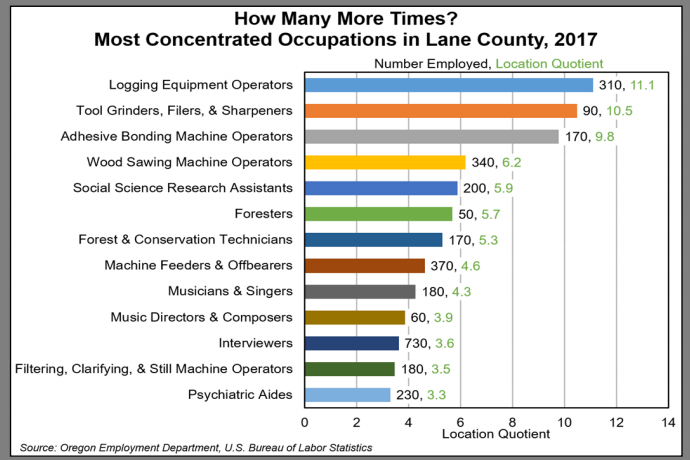Brews, Brains, and Lumber: Occupations Clustered in Lane County
by Henry Fields
Sometimes to understand an economy you need to look at the things that make a place unique.
Location quotients (LQ) are a tool that help analysts do just that. LQs compare local employment in one industry or occupation with the nation as a whole.
It’s basically like looking at the whole U.S. economy as a pizza. The toppings scattered unevenly across the pizza represent different kinds of jobs. A location quotient takes out one particular slice and compares the toppings you find locally to their national frequency.
The resulting number shows concentration – how much more or less of the “topping” we find locally than if that slice were a replica of the whole pie.
If you slice Oregon out of the national pizza, for example, you’re going to find a lot more forestry jobs among the toppings here than in the nation (LQ 7.9), and a lot less in petroleum and coal manufacturing (LQ 0.4).
An LQ of 7.9 means Oregon had nearly eight times as much employment in forestry and logging as you would expect in a slice our size, while 0.4 means we had 40 percent of petroleum and coal manufacturing employment relative to the whole pie. (Okay, I’ll drop the unappetizing metaphor.)
Since the formula is a simple ratio, LQs are flexible enough to apply to any geography, job, or sector for which you can find data.
For example, the graph below looks at the occupations with the highest location quotients in Lane County.

The role of forestry, logging, and wood products is evident. Logging equipment operators, saw sharpeners, woodworking machine operators, foresters, and conservation technicians were some of our most concentrated occupations.
It’s not surprising to find timber-related jobs that are 10 times more prevalent here than the nation, given the history of wood products and the world class natural resources in our region.

Also unsurprising are concentrated jobs in education and health care. Social science research assistants may work at U of O or related research institutions. Interviewers are often employed in health care settings, in university research, or in business support, all local strengths. Psychiatric aides, who might be employed in private facilities or the Junction City campus of the Oregon State Hospital, also make the list.
We live the good life in Lane County, and that’s obvious from our concentrated occupations, too.
I was intrigued to find that musicians and music directors are quite prominent here, which is exciting for an area that prides itself on art and culture.

There are more than three times as many filtering, clarifying and still machine operators – which humans would call brewers – as expected, confirming we punch above our weight when it comes to beer.

Although most of these occupations aren’t very large, LQs still allow us to point to the local jobs that are relatively unique.
If your passion is forestry, woodworking, education, health, music or beer, it’s safe to say you’re not alone in Lane County.
Henry Fields
Workforce Analyst Lane County
henry.l.fields@oregon.gov
1401 Willamette Street Eugene, OR 97401


Advertisement